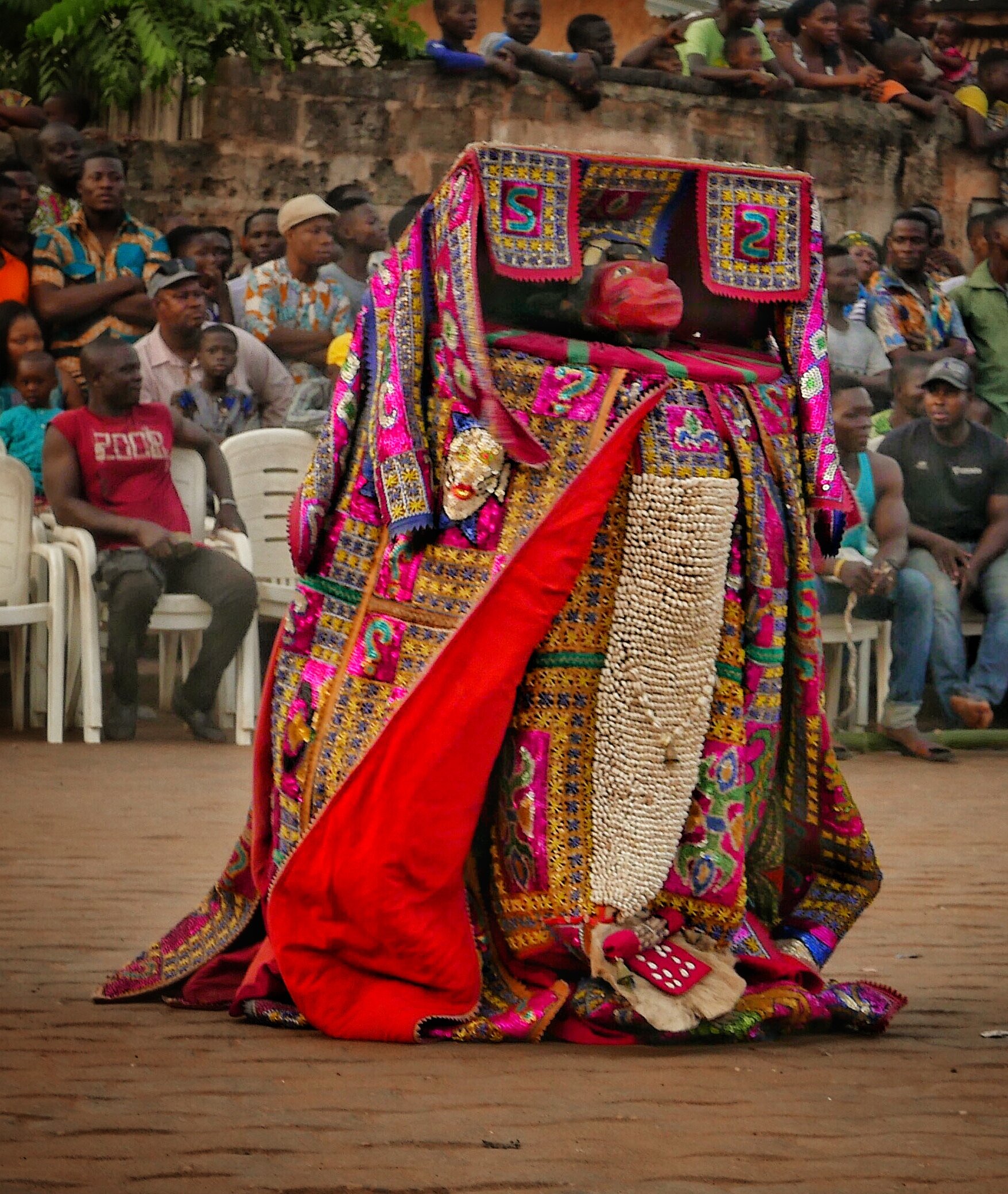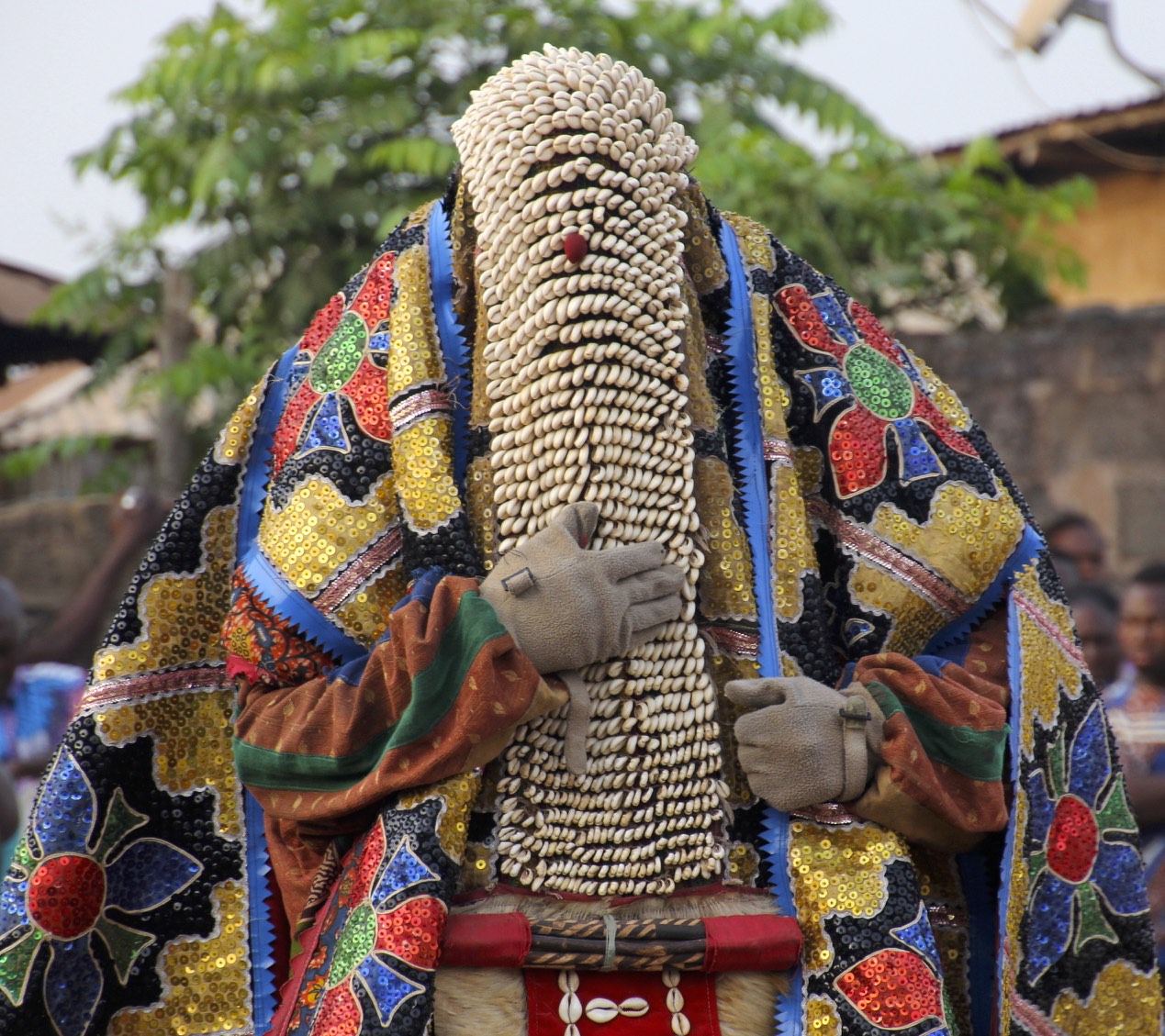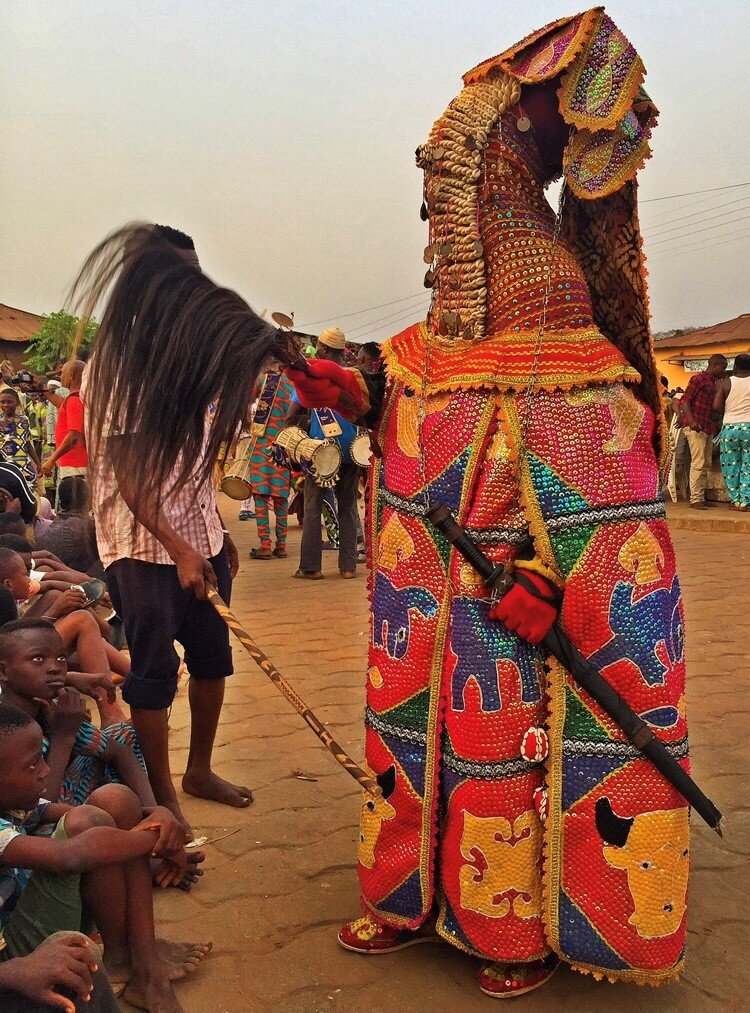The Egungun is a secret society of masqueraders of the Yoruba People who live in the area of Western Nigeria and Eastern Benin. The Egungun worship the ancestors and provide a means of contact with the ancestral spirits. The masks worn by the Egungun represent a spirit of a particular person.
This is a good summary of the ceremony by James Dorsey (www.perceptivetravel.com):
To the adherents of traditional African voodoo there is no difference between the waking world and that of spirits, they are the same, co-existing in what a westerner might call a parallel universe. The living and the dead are in constant communion, aiding each other just as they did in physical life. It is the job of the mambo, or griot, the West African version of a priest, to oversee this union, to guide it using established traditions that allow the living to navigate among the dead without being totally drawn into that void. While they believe the deceased are constantly among us, they also believe a living person can enter the twilight world for brief periods if under careful guidance, and of course depending on the personal power of the metaphysical traveler. The witch doctor or shaman are nothing more than spiritual guides who facilitate communication between those who have gone before and those who still occupy the material world.
The ceremony is presided over by a council of griots, or mambos as they are known locally; there are usually several in attendance, but the uninitiated will not know who they are. They are secret masters of ceremony, making sure all goes according to plan, and ready to make judgment calls if things get out of hand, as I was about to find out.
The Egun Gun are a secret society of men who spend most of their adult life learning an archaic set of rituals, prayers, and ceremonial traditions, that include their own private language and dances. They spend great amounts of time creating surreal looking outfits that hide not only their true identity, but emphasize the fact that the wearer is in a special place and not of this world.
They are so secretive that fellow tribal members do not know who is a member or not, and that days before a ceremony an Egun Gun dancer secrets his homemade ceremonial costume in the woods and makes excuses to disappear so no one will know where he is going and no one will ask why. During this time he prepares himself through fasting and prayer. Even more fascinating is the fact that once the ritual begins, he becomes the living dead. The Egun dance is tradition and religious rite simultaneously, as much theater as ceremony, part Kabuki and part melodrama, but deadly serious.
Once in costume and mask the dancer is no longer a member of the material world. He enters a trance like state, becoming a conduit for a deceased relative to enter his body. When this is achieved the dancer will begin to gyrate and contort in ways not normally doable in a waking state. The idea is that the dancer mimics all he has seen from his fellow tribesmen during the period since the last dance, showing the spirit inside him what everyone has done lately. This in turn allows the spirit to know who has been good or bad and who needs to be punished or rewarded. Ancestors, who are never far away, are the keepers and arbitrators of how their families should live and this dance is their periodic checkup. But being spirits, benign or not, they all hold a "terribelita" that once unleashed could wreak havoc if not properly controlled by ceremony.
Having any contact whatsoever with an Egungun can prove deadly for both the Egungun and the other person, so each Egungun is accompanied by a 'minder', also a member of the Egungun society, who carries a long stick to drive individuals away. It is believed that even seeing a part of a body of the dancer can result in death.
Egungun is a dance performance that opens a portal between the realm of the dead and the living. During the dance, the ancestors send blessings to the spectators and the entire community.
An Egungun man has an elaborate flowing coat which is sewn all the way to the top over his head with beads and shells. Masqueraders enter in a state of ecstasy when they perform and their anonymity is of the upmost importance in the Egungun. Once wearing the costume, the performer ceases to be himself and become the ancestor. The Yoruba concept of spirit is that it exists before birth and continues after death. The corporal life is therefore a temporary state. The spirit can be evoked as it exists independent of the body.
Bata drums are associated with Sango - the god of thunder - and they are usually played during celebrations held in honor and praise of him. The drums have different uses and functions in Yoruba society; some of these functions include enriching and vitalizing certain traditional practices and ceremonies such as Egungun festivals. One of the most important parts of Egungun dancing is "communication and the language of the drums.” Dance in Yoruba religious traditions is of utmost importance because it is one of the methods through which the gods can be contacted and engaged with. For instance, during Egungun ceremonies, the Bata drums are used to communicate with Sango.
The Egungun conceal their faces with layers of cloth, animal skin and strange structures of shells and baubles. Their many layers of colored cloth, embroidery, leather, animal skin, shells and beads, and their masks, completely obliterate the human form. It is through concealment of the human body that the spirit is revealed.
The dancers dress elaborately to reflect the prestige of the ancestor they portray, and exquisite cloth is used in their distinctive outfits to honor the grandeur of those the represent. On many of their draperies animals are embroidered into the fabric as part of their representation of the dead.
Egungun are escorted by other members of the Egungun society who act as crowd controllers. People try to hide or run away from them because they fear that if touched they will die shortly after.
Egungun wear a base layer made of Aso-Oke, which resembles the shroud in which the dead are wrapped. They also wear netting for the face and hands, which hides features which may reveal their identity. Only men can participate as masked ancestors, although women still play an integral role in dancing and helping to create the costumes.
The layering is a mark of the owner’s prestige; it also makes the transformation of the dancer possible. Skilled and energetic dancing results in the cloth panels flaring out, exposing the multiple layers and coloured under-surfaces, and completely transforming the appearance of the Egúngún. The movement of these cloths generate what researchers have termed a ‘breeze of blessing’ through the crowd.
When the performance is completed, the performers as Egungun give messages, warnings and blessings to the assembled spectators. Here a man uses a stick packed with animal fur to waft the knowledge of the dead and his blessings onto a townsman.
The identity of the dancer is concealed – Egúngún can be translated as “powers concealed” – the work of the performer is to bring the costume to life and in doing so, to lose his identity in that of the ancestor whose powers will be brought forward.
Men perform the Egúngún; women participate in the ritual dances and sing praise poems.
‘Believed to be the embodiment of ancestral sprits, an important context for these masks is to provide a farewell visit following the death of any senior men in families that belong to the mask society. A few weeks after the burial, a mask will emerge from the dead man’s room, dressed in his old clothes, to rebuke any quarrelling family members, say farewell to his wives and children, and perhaps accuse someone of responsibility in his death. Other Egúngún perform at an annual town festival, parading thorough the streets with a gang of followers, often surrounded by a posse of excited young men, with sticks who chase and beat each other and youths in the crowd. As embodiments of the ancestors, the more important of these masks are thought by many to have healing powers and often women who are having problems, especially relating to fertility, will kneel and supplicate the spirit for assistance. Small gifts of money are made to the mask’s attendants, and if the problem is subsequently resolved a chicken or some other sacrifice may be given. Certain masks will achieve reputations for successful intercession and ay accumulate a growing power, visibly represented on the mask itself by a growing encrustation of black sacrificial residues.’ (D. Clarke 1998)
There are different types of Egungun masquerades: onidan, idomole, and alubata. Onidan can be said to mean “owner of miracles.” The masquerades within this category exist mainly for entertainment purposes. They usually depict a wide variety of characters including priests, policemen and prostitutes. Idomole, on the other hand, translates to something which pleases the eye. Idomole masquerades can be considered as Egungun’s children. Their purpose is to honor the ancestors and their spirit(s). Finally, Alubata translates to "the one who plays the Bata drum."
This title can be said to refer to the Bata drummers who are present at the ceremonies where alubata masquerades perform. The alubata masquerades often wear very colorful shrouds and are the highest ranking masquerades. That they rank the highest and have a name which is associated with Bata drummers can be considered as being quite significant. Perhaps it implies that the collaboration between the alubata masquerades and Bata drummers is necessary for effective communication with the spirits and gods through vibrant sounds and elaborate movements.
A Egungun chases men around the square, with his minder trailing behind holding a massive stick to ensure that order is preserved. The Egungun chase people throughout the ceremony. Once you show fear, the tribesman will hold and scare you till you give them some money.























































